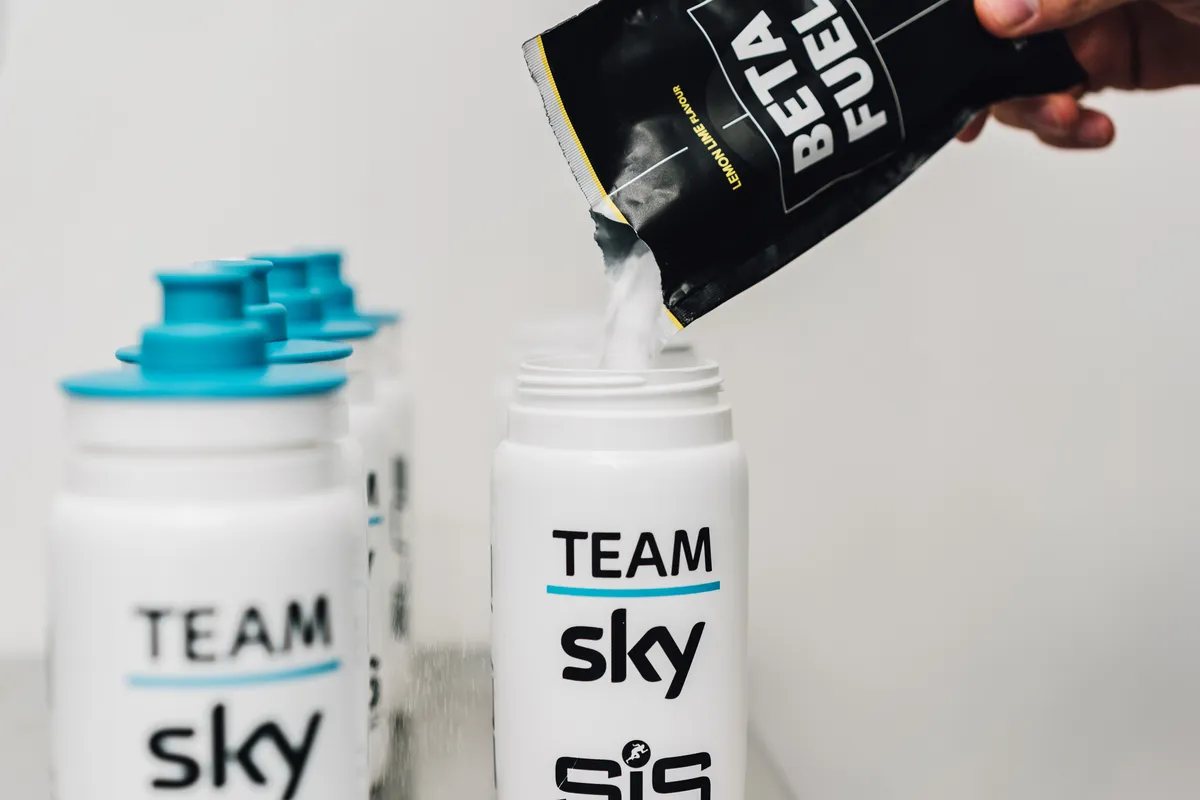Cycling’s history – and indeed Team Sky’s own – being what it is, there were no shortage of sceptics questioning how Chris Froome’s race-winning solo break on stage 19 of the Giro d’Italia was powered.
Team boss Dave Brailsford, however, reckoned the team’s nutrition strategy played a crucial role. The team’s employees, including Brailsford, were scattered across the course, handing Froome the nutrition he needed to charge his huge effort.
One of those products Froome had at his disposal was from their nutrition sponsor Science in Sport, a new drink called Beta Fuel that the two have collaborated on. As the name and package suggests, it’s still being trialled by the team and isn’t for public consumption just yet.
The basic premise is to provide the maximum amount of carbohydrate without upsetting the stomach. Each sachet delivers 2:1 Glucose to Fructose (54g and 27g respectively) through a PH neutral, isotonic formulation. The goal is to absorb the carbs rapidly while minimising gastrointestinal distress.
“The addition of fructose,” SIS’s spiel says, “means your body can oxidise up to 90g of carbohydrate an hour, up from the 60g per hour that is achievable via glucose alone.”
As a comparison, SiS's Go energy powder contains 48g carbohydrate per serving to Beta Fuel's 81g.

This is a new product for SiS, if not quite a new idea in endurance sport. Several companies already offer 2:1 glucose/fructose mixes, though, from what we've found in initial research, Beta Fuel offers the largest amount of carbs per serving. As comparisons, Etixx's Isotonic drink offers 35g carbs per 500ml and High5's Energy Drink has 44g per 500ml.
Research, particular that of sports nutritionist Asker Jeukendrup (2010), shows that glucose and fructose are absorbed through the intestinal wall through different mechanisms, so while fructose is absorbed more slowly than glucose, both can be absorbed at the same time, increasing the amount of carbohydrate the body can utilise per hour. It's particularly important on rides over 2.5 hours duration, when the body begins to need the extra resource.
So what’s Beta Fuel like? I've been trying out some samples (orange and lemon-lime flavours) over the past few weeks on my longer rides, including during the Marxa Jufre gran fondo in Catalonia late last month.
Beta Fuel has more viscosity than, say, SiS's Go powder. If you don’t shake the bottle regularly, the concentration gets higher and thicker the closer to the bottom of your bottle you get.
It's not overly sweet, as you might expect. In fact it’s got a surprisingly light taste. I got through two sachets in the 4 1/2, 115km gran fondo - my longest ride of the year so far - and got round without any fuss whatsoever. And as someone who struggles with gut issues, I'm pleased to report no issues to date while using Beta Fuel.
It wasn't a particularly warm day in Catalonia, but when it is, I'd imagine you'd need to use additional fluid sources above a 500ml bottle of Beta Fuel, given the body's capacity to absorb carbohydrate is limited and there's no need to drink more than one of these per hour. Disolving in a larger 750ml might be the way to go.
There's no word yet on when SiS will fully launch this product, but given it's already in use by Sky don't expect it to be too long.
You can subscribe to Cycling Plus here and check out our Facebook, Instagram and Twitter accounts for all of the latest road cycling action.

